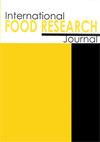Bioaccessibility of iron and zinc in selected complementary foods fortified with micronutrient powders in Kenya
IF 1
4区 农林科学
Q4 FOOD SCIENCE & TECHNOLOGY
引用次数: 0
Abstract
Fortification with micronutrient powders (MNPs) is recommended as a strategy for increasing the micronutrient content in complementary foods. However, plant-based diets commonly consumed in developing countries are rich in phytates and tannins, which decrease the micronutrient bioavailability. The present work analysed the relationship between the antinutrient content, and also iron and zinc bioaccessibility, in home-made MNP-fortified complementary feeding porridges refined with white rice, maize, white sorghum, finger millet, pearl millet, Irish potato, and banana samples, which were obtained from the local market and milled into flour. Porridges were prepared using the flour, cooled to 50°C, fortified with MNPs, and subjected to in vitro digestion. Total and bioaccessible zinc and iron were quantified using atomic absorption spectrometry. Tannins and phytates were analysed using Folin-Denis and high-performance liquid chromatography methods, respectively. Porridges were classified as having poor bioavailability if their phytate-zinc and phytate-iron molar ratios were > 15 and > 0.4, respectively. Only pearl millet and soybeans showed tannin levels higher than the recommended values. The lowest phytate level was observed in refined white rice (0.11 ± 0.04 g/100 g), and the highest was in pearl millet (2.83 ± 0.10 g/100 g). Zinc bioaccessibility ranged from 7.31% (finger millet) to 26.05% (corn-soy blend). Only pearl millet porridge was classified as having poor zinc bioavailability. Iron bioaccessibility ranged from 20.73% (refined white rice) to 0.62% (pearl millet). Refined white rice and Irish potato were the only foods with the phytate-iron ratio within the recommended range. Iron bioaccessibility decreased significantly with an increase in both tannin (r = -0.31, p = 0.045) and phytate (r = -0.39, p = 0.01) contents. Zinc bioaccessibility showed a significant positive relationship with tannin levels (r = 0.41, p = 0.008), but an insignificant inverse relationship with phytate levels (r = -0.072, p = 0.700). Iron bioaccessibility was adversely affected by phytate and tannin levels. To improve iron and zinc bioavailability in complementary foods, strategies for lowering the phytate and tannin contents at the household level are recommended.肯尼亚选定的添加微量营养素粉末的辅食中铁和锌的生物可及性
建议使用微量营养素粉(MNPs)作为增加辅食中微量营养素含量的一种策略。然而,发展中国家普遍食用的植物性饮食富含植酸盐和单宁,这降低了微量营养素的生物利用度。本研究分析了从当地市场获得的以白米、玉米、白高粱、小米、珍珠小米、爱尔兰马铃薯和香蕉为原料,经碾磨后制成的国产mnp强化辅食粥的抗营养素含量与铁和锌的生物可及性之间的关系。用面粉制备粥,冷却至50°C,添加MNPs,并进行体外消化。用原子吸收光谱法定量测定总锌和生物可及性铁。单宁和植酸分别用福林-丹尼斯和高效液相色谱法进行分析。如果粥的植酸锌摩尔比为>5,植酸铁摩尔比为>.4,则粥的生物利用度较差。只有珍珠粟和大豆的单宁含量高于推荐值。精白米中植酸含量最低(0.11±0.04 g/100 g),珍珠粟中植酸含量最高(2.83±0.10 g/100 g),锌的生物可及性为7.31%(指粟)~ 26.05%(玉米-大豆混合)。只有珍珠小米粥的锌生物利用度较差。铁的生物可及度为20.73%(精白米)~ 0.62%(珍珠粟)。精白米和爱尔兰马铃薯是仅有的植酸铁比例在推荐范围内的食物。铁的生物可及性随单宁(r = -0.31, p = 0.045)和植酸(r = -0.39, p = 0.01)含量的增加而显著降低。锌的生物可及性与单宁水平呈显著正相关(r = 0.41, p = 0.008),与植酸水平呈显著负相关(r = -0.072, p = 0.700)。铁的生物可及性受到植酸和单宁水平的不利影响。为了提高辅食中铁和锌的生物利用度,建议在家庭水平上降低植酸盐和单宁含量。
本文章由计算机程序翻译,如有差异,请以英文原文为准。
求助全文
约1分钟内获得全文
求助全文
来源期刊

international food research journal
Agricultural and Biological Sciences-Food Science
CiteScore
1.40
自引率
0.00%
发文量
75
期刊介绍:
The International Food Research Journal (IFRJ) publishes papers in English, six (6) issues a year with the coverage of:
Food Science and Technology
Nutrition and Dietetics
Agriculture, multidisciplinary
Chemistry, multidisciplinary
The scope of the Journal includes:
Food Science, Food Technology and Food Biotechnology
Product Development and Sensory Evaluation
Food Habits, Nutrition, and Health
Food Safety and Quality
Food Chemistry, Food Microbiology, Food Analysis and Testing
Food Engineering
Food Packaging
Food Waste Management
Food Entrepreneur
Food Regulatory
Post-Harvest Food Management
Food Supply Chain Management
Halal Food and Management
 求助内容:
求助内容: 应助结果提醒方式:
应助结果提醒方式:


